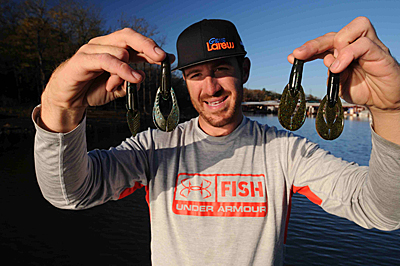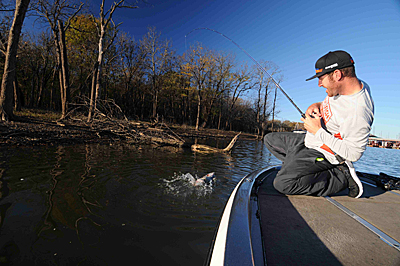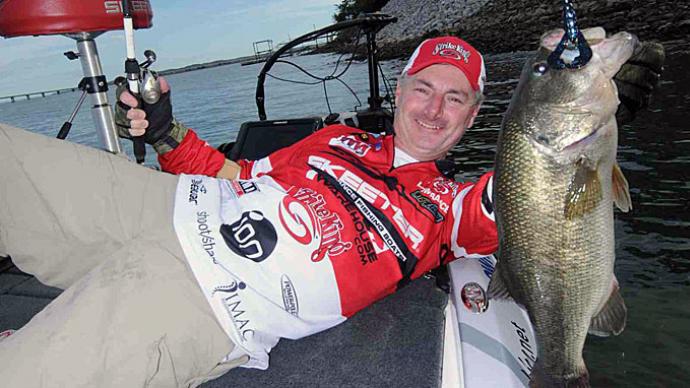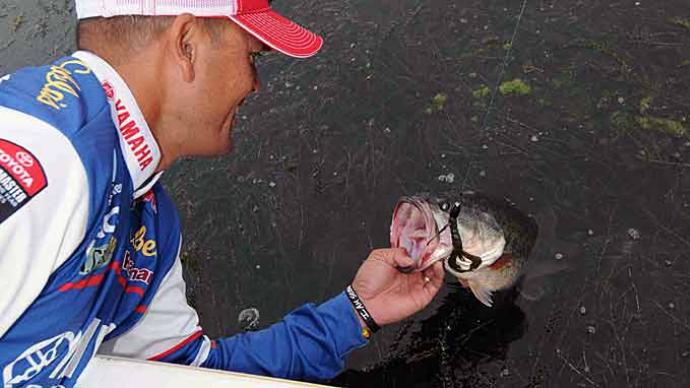
When Jacob Wheeler was a boy, he knew he would have to work on his mechanics to become a successful pro angler.
Wheeler knew one of the pros’ tactics he would have to master was the art of pitching a lure precisely and quietly to a target. So on those snowy winter days in Indianapolis, Ind., Wheeler would spend hours in his bedroom delivering his lure with an underhand pitch to a coffee cup. Those hours of practice have paid off as Wheeler is now one of the rising stars of professional bass fishing.
The Bassmaster Elite Series pro knows certain situations dictate whether he should pitch or cast his lures. “The biggest thing is when you are pitching, you are being very specific in where you are presenting that bait,” he says. “A lot of times when you are casting, you are covering a lot of water, but when you are pitching, you are fishing one particular thing.”
The Indiana angler describes pitching as a precise method for delivering a lure to a tight space where the strike zone might be only 6 to 8 inches wide. “When you are casting, it is hard to be that accurate,” he says.
Although he occasionally pitches jigs into grass beds 20 feet deep, Wheeler mainly relies on pitching as a shallow water tactic. “It works all year long, but there are times of the year when it works better,” he says. His favorite times to pitch lures are during the prespawn and spawn when bass are in the shallows.
“When you see a type of cover or a good-looking bank, whether it’s a channel bank with laydowns during the prespawn or a flat or pocket with some bushes in it during the spawn, that is when will be your opportunities to pitch,” Wheeler says. He favors pitching to laydowns, channel banks, or docks for staging prespawn bass in the spring. Water levels usually drop during autumn, and bass flock to wood cover, so Wheeler’s favorite pitching targets for fall fishing are flooded bushes or isolated wood.
Wheeler’s first pitch to a target is usually to the thickest part of the cover. “It is essential to make that pitch with a precise delivery and subtle splash,” Wheeler says. “Make sure it falls on a slack line which allows it to drop vertically since there is no tension on your line.” The quiet entry is critical on the calm bluebird days when stealth is needed to prevent spooking those shallow fish.

The action and profile of a lure are the key features Wheeler looks for in determining a bait to pitch. He favors the Gene Larew Wheeler’s Punch Out Craw for pitching because he can fish it in multiple ways to mimic forage or downsize when fishing pressure makes bass finicky. The spear-shaped tail of the Punch Out Craw can be kept intact to create a bulky lure with a gliding action, or the tail can be pulled apart, so the appendages create a smaller profile with a flapping craw action.
“If I want to pitch it to where it is bulky but has a little tail action, I can do that to imitate a bluegill,” Wheeler says. “If I want to trim it down and make it a craw, I can cut out the spear and pitch it as a craw bait.” His favorite lure colors include black/blue, green pumpkin, Sooner magic, and golden June bug.
Wheeler Texas rigs the lure with a 4/0 VMC straight shank hook and a 5/16-ounce VMC worm weight for most of his pitching applications. He opts for the lightest weight possible to get optimum action from his lure, but during the post-spawn and in the summertime, he upgrades to a 1/2- or 3/4-ounce weight for a faster fall to trigger reaction strikes.
Whether or not he pegs his sinker depends on the action he wants from his lure. “I always peg my sinker on a bait that has a lot of action,” he says. “So if I am throwing a Punch Out Craw and decide to have it with a craw action, I will peg it. If I want a gliding action for a tube bait or spear (tail), I don’t peg the weight because there is not as much drag on that bait.” He notes the lure glides better when the weight slides away from the bait.
The pitching process begins by letting out line to where the lure is just past the reel. Hold the lure with a couple of fingers and release it while lifting the rod so the lure will propel toward the target. The key to the delivery is to keep the lure close to the water as it pendulums to the target to make a soft entry. Once the lure touches down, quickly close the bail because strikes can occur the second the lure enters the water.
The lure presentation varies depending on certain factors. Aggressive bass usually bite the lure on the initial fall. Sometimes the strike occurs after hopping the lure a couple of times in the cover. During the spawn or heavy fishing pressure, it might be necessary to let the lure sit still for five seconds or more to trigger a strike.
Wheeler usually pitches his lures with a 7-foot, 3-inch heavy action Okuma Psycho Stick rod, which has good parabolic action for delivering his Texas-rigged baits with 5/16- and 1/4-ounce weights. For pitching into thick cover with heavier sinkers, he prefers a 7 1/2-foot heavy action Okuma Psycho Stick rod which provides more leverage and backbone for winching bass out of bushes and other heavy cover.
The B.A.S.S. pro favors pitching with a high-speed baitcast reel (8.1:1 Okuma Hakai model) for quickly retrieving line after a strike. “A lot of times when a bass bites (in shallow cover), it will take off and come toward you, and you have to reel up that slack,” he says. Wheeler pitches with 14-pound Sufix Castable Invisiline 100 Percent Fluorocarbon to rock banks or bluffs but switches to 17-pound fluorocarbon when pitching into heavy cover.
BassResource may receive a portion of revenues if you make a purchase using a link above.




